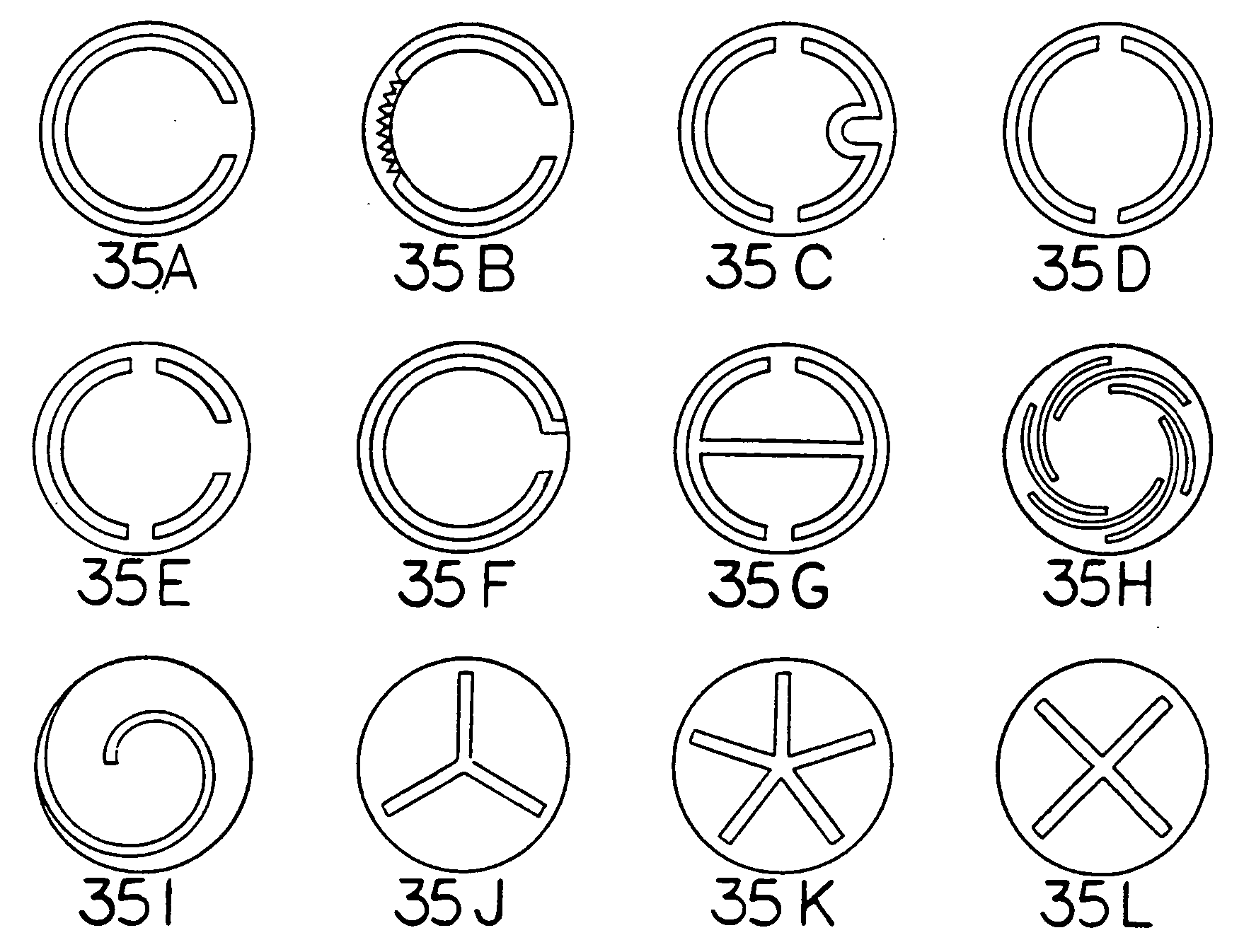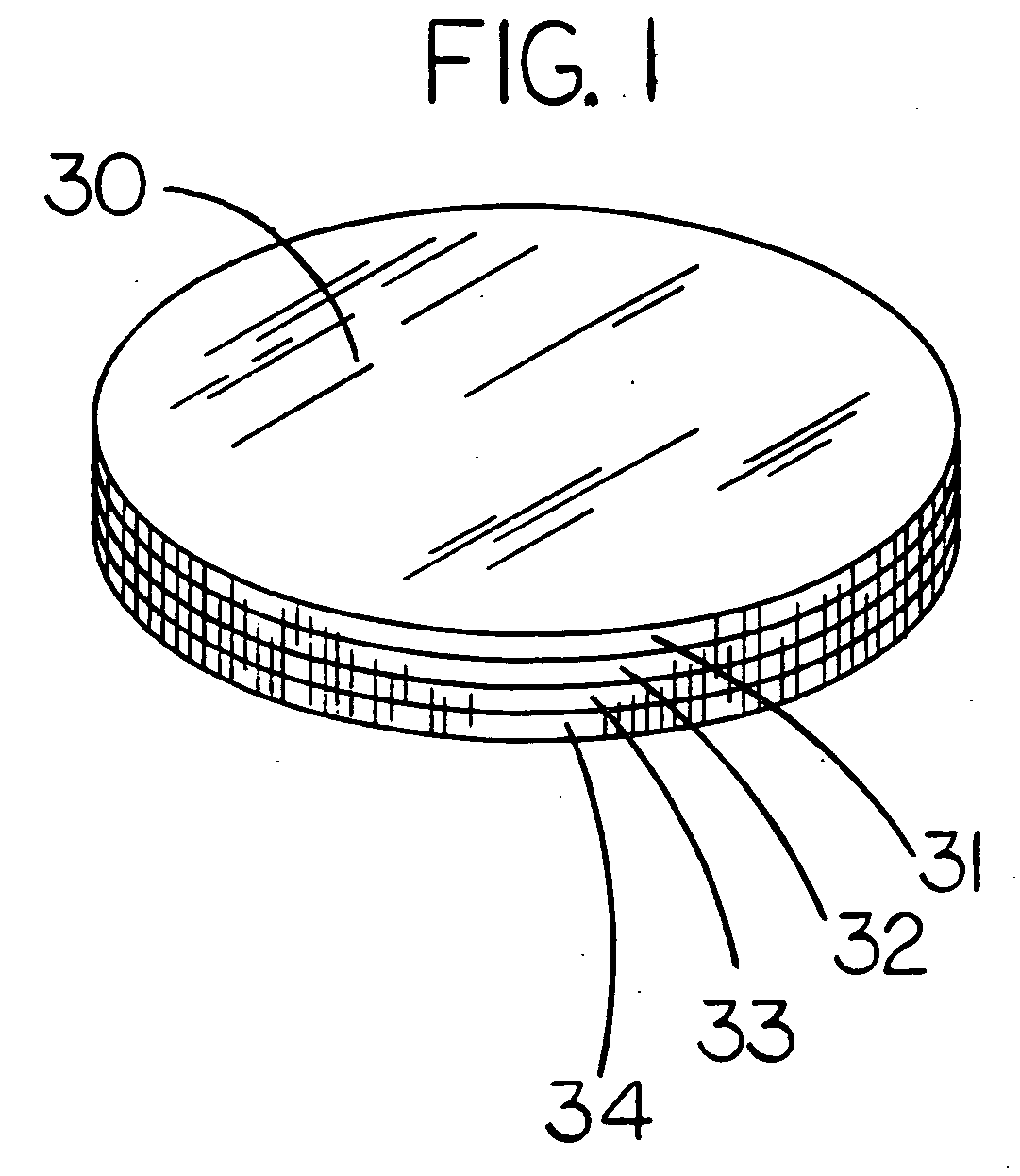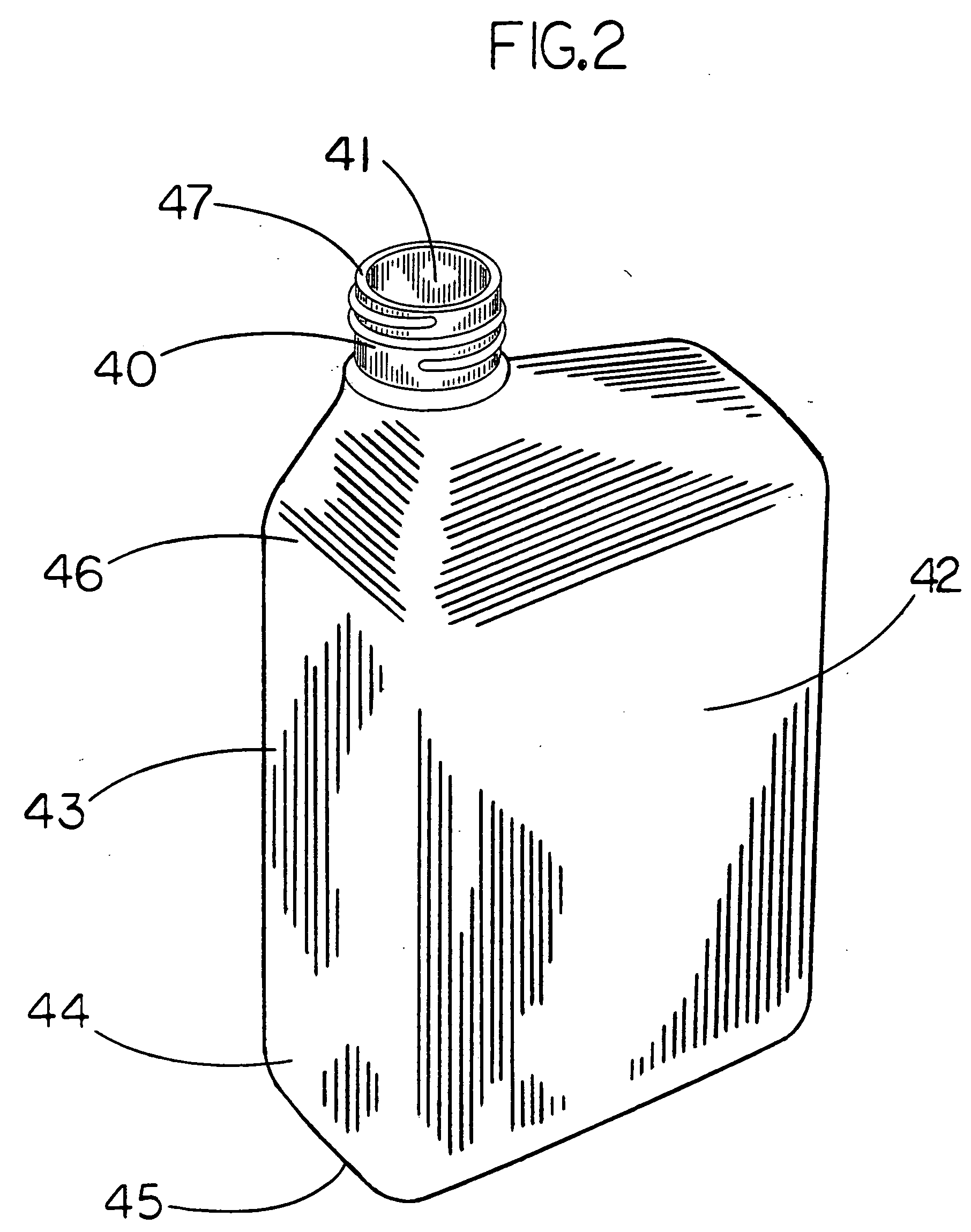Not only did the can type container suffer from a high
leakage rate, it would also most likely burst when dropped.
When such flexible
plastic bottle type replacements first came into popular use, there were problems associated with the design of the closure caps that caused seepage and leaking of the contents in many containers beyond acceptable limits.
Although performing well in this function, these seals proved to be extremely difficult to be removed by hand, requiring the consumer to provide a sharp tool just to open the product.
However, despite the advances made in closure caps to prevent leakage, they have fallen far short of solving the problem.
Incorrect torqueing of the screw on closure cap, dropping of the container, jarring through shipping or loading, or poor fit of the
gasket, can all cause container leakage prior to the removal of the closure cap.
Even with the addition of a locking tear strip at the lower outer perimeter of the closure cap, this type of container can still leak and contains no
backup provision to prevent it.
In addition to problems with leakage, a second and more serious
disadvantage with the flexible plastic container as currently provided, is the extreme difficulty a user experiences when trying to pour the liquid from the container into a narrow fill opening without the contents spilling everywhere.
An extremely difficult task even in the best of conditions.
When attempting this procedure it becomes obvious that the
likely outcome is the container contents end up being spilled into the engine compartment and then drip on to the ground and pollute the environment.
A more serious consideration is the possibility of the contents flowing onto hot engine components creating
noxious fumes and possible fire.
Although a motorist can avoid this by using a fill funnel, this also has its drawbacks, the funnel becomes covered by the container contents and has to be cleaned after each use, or too often a funnel isn't available when needed.
Recognizing this need, some self serve gas stations provide a disposable paper funnel, but then a further problem is, these paper funnels become
hazardous waste when soaked with
petroleum products, are a waste of natural resources, and are of a considerable cost to the consumer in the form of higher prices.
However, each of the embodied
design methods employed by the prior art and described herein, manifest similar and differing drawbacks.
However, this method gives no provision for the possibility that portions of the seal material may tear away and contaminate the contents when the seal bursts open, which could damage the motor by clogging the internal flow of
lubrication to critical components.
However, with this method there is no provision given for the possible damage that may be caused to the motor by altering the lubricating qualities of the oil by repeatedly contaminating it with melted seal material, or that portions of the seal material may tear away when opened and damage the motor during warm up by clogging the internal flow of
lubrication to critical components when a consumer inadvertently adds oil to a cold engine.
There is also the inconvenience of having to wait for the motor to warm up before being able to add oil.
However, with this method there is no provision given for the possibility that using a releasable
adhesive with a
bond strength that is weak enough to allow the seal to delaminate from the container rim when the inverted container is squeezed, would also allow the seal to delaminate when the closure cap is rotated.
Rotation of the closure cap while it is compressed against the seal during installation or removal produces a shearing force that could force the releasable portion of the seal to lose its bond and rotate with the cap which would cause the seal to
pleat against the fixed portion resulting in leakage and opening of the seal.
Additionally a tack type releasable
adhesive with low adhesion characteristics could also be vulnerable to degradation from the volatile organic compounds present in many
petroleum based products that could negatively affect the seals ability to remain bonded to the container rim when a given pressure is brought to bear.
Rotation of the closure cap while it is compressed against the seal during installation or removal produces a shearing force that could force the releasable portion of the second layer to lose its bond and rotate with the cap which would cause the second layer to
pleat against the fixed portion resulting in leakage and opening of the seal.
Additionally a tack type releasable
adhesive with low adhesion characteristics could also be vulnerable to degradation from the volatile organic compounds present in many
petroleum based products that could negatively affect the second
layers ability to remain bonded to the first layer when a given pressure is brought to bear.
However, with this method there is no provision given for the problem of the seal leaking through the perforations, slits, or vent holes during shipping or handling.
To prevent this, it would be necessary to include an additional seal in the form of a resilient
gasket between the closure cap and the seal which would increase the cost of the container.
Additionally, the vent holes, slits, or perforations would also leak from the pressure created when the container is gripped and inverted by a consumer which would allow the container contents to drip into the motor compartment making a mess or worse drip onto hot engine components creating
noxious fumes and possible fire.
However, using any of the various techniques described in these two prior art patents to fabricate a thinned breaking pattern that will leave the precise material thickness necessary for the seal to remain intact when the filled container is lightly gripped and inverted, and then consistently burst at a squeezing pressure that by necessity has to be very low, present considerable manufacturing and fabrication drawbacks described herein.
The higher the
burst pressure of the seal, the more likely the volume of liquid gushing out of the container pour spout will exceed the inflow capacity of the fill opening which will cause the liquid to back up and overflow when the seal bursts open.
When a weakened breaking pattern has to be created by
thinning an area of the seal material to approximately one ten thousandth of an inch thick, within tolerances approaching one one hundredth thousandth of an inch (0.00001″), as is the case with
aluminum foil, each of the various
thinning schemes used in the prior art patents such as; scoring, milling, boring, compression, molding, or
laser cutting fail to provide the control necessary to meet these requirements.
It should be immediately obvious even to those unskilled in the art, that the seal material will most likely tear when this is attempted.
Even if this could be accomplished at all, it would be a very
time consuming process that would most likely produce
quality control problems and a high defect rate which would cause inconsistent burst pressures from one seal to the next.
Again, it should be immediately obvious even to those unskilled in the art that the seal material will most likely tear when this is attempted.
Even if this could be accomplished at all, it would also be a very
time consuming process that would again, most likely produce
quality control problems and a high defect rate which would cause inconsistent burst pressures from one seal to the next.
Drawbacks such as allowable
machine tolerances or incremental
tool wear alone would be sufficient to produce defects that would cause inconsistent or premature
bursting of the seal.
Manufacturing a self opening seal with a thinned breaking pattern using a molding process such as injection or
vacuum forming requires the seal to be fabricated from heated plastic material which presents a number of significant disadvantages.
Because of the elasticity and expansion coefficient of
plastic materials, the ability to consistently control the depth of the thinned area of the breaking pattern to the tolerances required is beyond the capabilities of either process.
Injection molding and
vacuum forming also require expensive multi cavity molds that must be replaced regularly adding to the
unit cost of each seal.
Manufacturing the closure seal by molding is also a
time consuming process which would also add to the
unit cost of each seal.
And lastly, creating the thinned area of the breaking pattern by
laser cutting would present different but even more intractable problems.
Attempting to melt the seal material to a particular depth with a
laser will not produce a precisely thinned breaking pattern.
An industrial laser is ideally suited to
cutting completely through any type of material in a very precise manner, for instance, to create slits or perforations, but it is totally ineffective when attempting to use it as a scoring device or milling
machine.
Vaporizing the seal material with the use of a laser is an explosive event that would not leave the precisely thin and delicate layer of intact material necessary for the seal to function properly, if it left any material at all.
This method would also be a time consuming process that would add to the
unit cost of each seal.
Additionally, the design of each of the prior art seal embodiments require fabrication methods do not allow the closure to be easily manufactured in a high speed manner that will produce a
defect free seal at the lowest possible cost.
In addition to the aforementioned drawbacks in all of the prior art patents, a further drawback is the inability of any of the closure seal embodiments to be manufactured and bonded over a container opening by using the existing
induction sealing process which is a significant
disadvantage.
A layer of hot, heat releasable adhesive is then applied to the opposite side of the foil sheet which becomes tacky after cooling.
The prior art patents described herein cannot utilize this efficient fabrication and installation method for a variety of similar and differing reasons thereby preventing the prior art from benefiting from the economies realized.
To eliminate this requires that the adhesive be zone specific applied to each individual seal only in the area contacting the rim, an inefficient and time consuming process that cannot be incorporated into the existing
induction sealing process.
The closure seal of U.S. Pat. No. 4,949,857 to Russell uses a weakened breaking pattern that would be prevented from
bursting by the underlying layer of
hot melt adhesive, also requiring the adhesive to be zone specific applied to each individual seal only in the area contacting the rim, again an inefficient and time consuming process that cannot be incorporated into the existing
induction sealing process.
Again, the necessary layer of
hot melt adhesive prevents both designs from being able to be adapted to the induction sealing process either by resealing the slits or perforations when melted or not allowing the thinned area of the breaking pattern to burst when the container is pressurized.
To over come this the
hot melt adhesive would also have to be zone specific applied to each individual seal only in the area contacting the rim, again a time consuming process for fabricating large quantities of the closure seal that cannot be incorporated into the existing induction sealing process.
 Login to View More
Login to View More  Login to View More
Login to View More 


